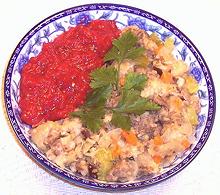
SAFARI
Users
General Discussion
Stuffing and Dressing are made from the same recipes except Dressing will have about 2 cups of chicken stock added. Stuffing is stuffed into the turkey where it is exposed to juices from the bird. Dressings are put in a casserole and baked, getting their juices from the added chicken stock.
Critical to producing a wonderfully moist and tender turkey with a crisp and tasty skin is precise control of temperature and roasting time. Stuffing the turkey makes this more complex and more difficult because it may not be up to the recommended minimum temperature (160°F) by time the meat has reached it's recommended minimum temperature (165°F - thickest part of thigh). With care this problem can be minimized.
Some chefs roast the turkey up to its final temperature, then while it's resting scoop the stuffing out into a casserole, add a little stock and bake it, first covered, then uncovered for some browning on top. This is also a good fall-back method if your stuffing just isn't going to be up to temperature. I'd leave the front cavity stuffed because it's sure to be up to temperature and removing it would ruin the presentation of the roasted bird.
Stuffing generally provides little flavor to the turkey because it just doesn't get hot enough to exude aromatic fumes, and liquids drip downward, so making it as dressing won't have a noticeable effect on the meat. On the other hand, especially if some falls out, it can definitely have an effect on the pan drippings, so if you're going to make gravy, and are going the dressing route, you might toss a handful of dressing into the roasting pan with the vegetables.
Equipment
You'll need a copious sauté pan - 5 quarts is fine, and for dressing you'll need a 4 quart baking dish.
Recipes
There are thousands of stuffing recipes, but they all follow pretty much the same pattern:
- Starch: usually bread or corn bread but sometimes rice or pasta
- Fat: usually provided by butter, sausage or bacon.
- Aromatic Vegetables: onions, celery, carrots.
- Sweetener: apples, raisins, chestnuts etc.
- Herbs & Spices
Here are a couple I've tested, but you'll find hundreds more in cookbooks and on the Internet.
- Sausage Sauerkraut Stuffing - savory and aromatic, one of my favorites.
- Sausage Cornbread Stuffing - savory and aromatic, one of my favorites.
Stuffing Procedure
- Get your stuffing all made up in accordance with your chosen recipe, except mixing in the bread cubes.
- Pull your turkey out of the fridge and let it sit in the kitchen uncovered for about an hour to take the chill off it. This is safe because only the outside is likely to get above 40°F and that part's going to go way over a safe temperature while roasting.
- When the turkey is just about to go into the oven, and not at all before, bring your stuffing up to a full simmer temperature, take it off the heat, mix in the bread cubes and start stuffing as soon as you can handle it. Thick rubber gloves can help here - the ones recommended for lifting the turkey are fine.
- Stuff the front first. Stretch the skin over the stuffing and pin it behind the neck with a bamboo skewer. The front of the turkey should now have a natural contour as if the turkey had just finished a good meal.
- Stuff the main body cavity of the turkey - not too tight since some stuffings expand just slightly while cooking. Some stuffing will be exposed between the legs, this isn't a problem, but see that it's firm enough so it won't all fall out when you turn the turkey breast side down, as you will for the first phase of roasting. See our page Roasting a Turkey for complete procedures.
- When the turkey has reached the target temperature of 160°F, (thickest part of thigh), check the stuffing in the center of the main cavity and make sure it's at 155°F (both temperatures will rise 5°F while the turkey is resting). If it's not up there you're going to have to scoop it out, put it in a baking dish with a little stock, and bake it in the oven for 20 minutes. Leave the front stuffed as it will certainly be up to temperature.
Dressing Procedure
Note that I recommend a hybrid system. Stuff the front cavity of the turkey as described above. Set up the rest as Dressing as described below. That stuffed into the front cavity won't be a lot, and will certainly achieve a safe temperature, and it makes the bird look better.
- Get your dressing all made up in accordance with your chosen recipe, just as for stuffing. I recommend doing this in advance, so you can use some of it to stuff the front cavity of the Turkey - and, because you'll probably have plenty of other stuff to do while the Turkey is roasting.
- Butter a 4-quart baking dish to get it ready.
- When the turkey has reached the target temperature and been brought out to rest, mix stock with the stuffing. The amount should be enough to get the bread real moist but not disintegrate it into mush, generally about 2 cups.
- Load the dressing into the baking dish, cover it with foil and put it in the oven (you're probably putting a side dish in there at this time too).
- Bake for about 25 minutes at 375°F, (apply windage for whatever temperature any other side dish needs), then pull off the foil and continue to bake another 10 minutes or until crispy on the top.
- Serve in a bowl or dished out into individual portions as you desire.


